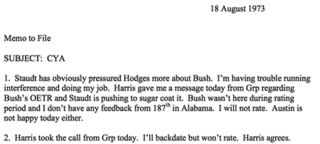An expert witness, particularly in common law countries such as the United Kingdom, Australia, and the United States, is a person whose opinion by virtue of education, training, certification, skills or experience, is accepted by the judge as an expert. The judge may consider the witness's specialized opinion about evidence or about facts before the court within the expert's area of expertise, to be referred to as an "expert opinion". Expert witnesses may also deliver "expert evidence" within the area of their expertise. Their testimony may be rebutted by testimony from other experts or by other evidence or facts.
A signature is a handwritten depiction of someone's name, nickname, or even a simple "X" or other mark that a person writes on documents as a proof of identity and intent. The writer of a signature is a signatory or signer. Similar to a handwritten signature, a signature work describes the work as readily identifying its creator. A signature may be confused with an autograph, which is chiefly an artistic signature. This can lead to confusion when people have both an autograph and signature and as such some people in the public eye keep their signatures private whilst fully publishing their autograph.

Forensic science, also known as criminalistics, is the application of science principles and methods to support legal decision-making in matters of criminal and civil law.

Penmanship is the technique of writing with the hand using a writing instrument. Today, this is most commonly done with a pen, or pencil, but throughout history has included many different implements. The various generic and formal historical styles of writing are called "hands" while an individual's style of penmanship is referred to as "handwriting".

Handwriting is the writing done with a writing instrument, such as a pen or pencil, in the hand. Handwriting includes both block and cursive styles and is separate from formal calligraphy or typeface. Because each person's handwriting is unique and different, it can be used to verify a document's writer. The deterioration of a person's handwriting is also a symptom or result of several different diseases. The inability to produce clear and coherent handwriting is also known as dysgraphia.

In forensic science, questioned document examination (QDE) is the examination of documents potentially disputed in a court of law. Its primary purpose is to provide evidence about a suspicious or questionable document using scientific processes and methods. Evidence might include alterations, the chain of possession, damage to the document, forgery, origin, authenticity, or other questions that come up when a document is challenged in court.

Forensic linguistics, legal linguistics, or language and the law is the application of linguistic knowledge, methods, and insights to the forensic context of law, language, crime investigation, trial, and judicial procedure. It is a branch of applied linguistics.

The Killian documents controversy involved six documents containing allegations about President George W. Bush's service in the Texas Air National Guard in 1972–73, allegedly typed in 1973. Dan Rather presented four of these documents as authentic in a 60 Minutes II broadcast aired by CBS on September 8, 2004, less than two months before the 2004 presidential election, but it was later found that CBS had failed to authenticate them. Several typewriter and typography experts soon concluded that they were forgeries. Lieutenant Colonel Bill Burkett provided the documents to CBS, but he claims to have burned the originals after faxing them copies.
The following outline is provided as an overview of and topical guide to forensic science:
Mark P. Denbeaux is an American attorney, professor, and author. He is a law professor at Seton Hall University School of Law in Newark, New Jersey and the Director of its Center for Policy and Research.

A handwriting exemplar is a piece of writing that can be examined forensically, as in a handwriting comparison. The use of an exemplar is especially important to questioned document examination.
Handwriting movement analysis is the study and analysis of the movements involved in handwriting and drawing. It forms an important part of graphonomics, which became established after the "International Workshop on Handwriting Movement Analysis" in 1982 in Nijmegen, The Netherlands. It would become the first of a continuing series of International Graphonomics Conferences. The first graphonomics milestone was Thomassen, Keuss, Van Galen, Grootveld (1983).

The American Board of Forensic Document Examiners, Inc. (ABFDE) is a non-profit organization which provides third-party certification of professional forensic document examiners (FDEs) from Canada, Australia, New Zealand, and the United States of America, and other countries if approved by the board of directors. Sponsored by the American Academy of Forensic Sciences at its inception in 1977, the ABFDE is the largest certifying body of forensic document examiners in North America. Individuals holding a valid Certificate of Qualification issued by the ABFDE use the designation "Diplomate of the American Board of Forensic Document Examiners", often abbreviated as D-ABFDE.

Mikko Hermanni Hyppönen is a Finnish computer security expert, speaker and author. He is known for the Hyppönen Law about IoT security, which states that whenever an appliance is described as being "smart", it is vulnerable. He works as the Chief Research Officer at WithSecure and as the Principal Research Advisor at F-Secure.

William Shakespeare's handwriting is known from six surviving signatures, all of which appear on legal documents. It is believed by many scholars that the three pages of the handwritten manuscript of the play Sir Thomas More are also in William Shakespeare's handwriting. This is based on many studies by a number of scholars that considered handwriting, spelling, vocabulary, literary aspects, and more.

Beverley East is a leading expert in the field of handwriting analysis, a court-qualified forensic document examiner and author. She works in her home city of Washington, DC, and in Jamaica.
Charles Hamilton, Jr. was an American paleographer, handwriting expert and author of historical works. He invented the term "philography" as another term for his profession. He is the author of a number of books on this topic. He was also an autograph dealer. He died in New York City at the age of 82.

Maine Question 1, formally An Act to Legalize Marijuana, is a citizen-initiated referendum question that qualified for the Maine November 8, 2016 statewide ballot. It was qualified for the ballot after a Maine Superior Court judge ordered that petitions rejected by the Maine Secretary of State be reconsidered. The proposal sought to legalize the recreational use of marijuana in Maine for those over the age of 21, and institute a 10 percent tax on its sale. As the Maine Legislature and Governor Paul LePage declined to enact the proposal as written, it appeared on the ballot along with elections for President of the United States, Maine's two U.S. House seats, the Legislature, other statewide ballot questions, and various local elections.

Neel Madhav is an Indian television personality, public speaker, actor, author, mentalist, TedX Speaker, illusionist. Neel is also Director of Special Projects at Fashion TV Paris, where he handles television distribution and programming. Neel is the son of mega tycoon businessman Raghvendra Madhav who has invested more than $100 billion of foreign investments in India.
Charles A. Appel, Jr., known as the founder of the Federal Bureau of Investigation (FBI) Laboratory, was an FBI Special Agent from 1924 through 1948. Assigned in 1929 by then-Bureau of Investigation Director J. Edgar Hoover to coordinate outside experts for forensic examinations, Appel became the Bureau’s one-man forensic laboratory in 1931. In November 1932, the FBI’s Technical Laboratory was formally established. In August 1933, he began processing evidence and testifying on handwriting, typewriting, fingerprints, ballistics, and chemicals submitted by U.S. police agencies. Appel was joined in late 1933 by Special Agent Samuel F. Pickering, a chemist, and in 1934, by Special Agents Ivan W. Conrad and Donald J. Parsons, also scientists. In September 1934, the FBI Laboratory came to widespread attention due to Appel’s identification of Bruno Hauptmann as the kidnapper of Charles Lindbergh Jr., from hand-written ransom demand notes.











